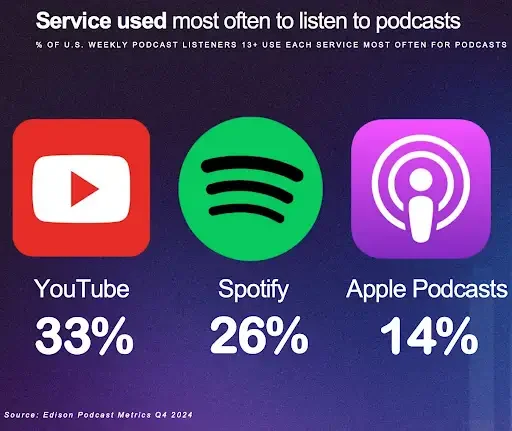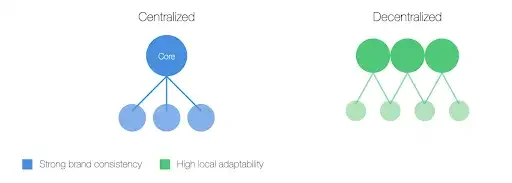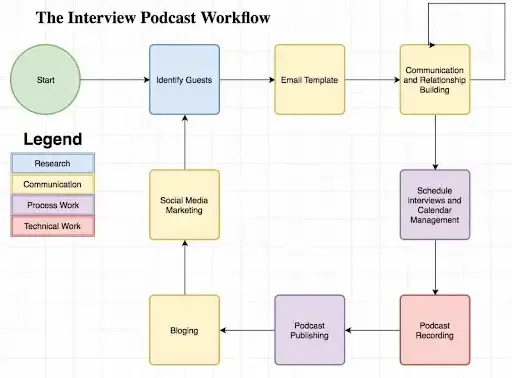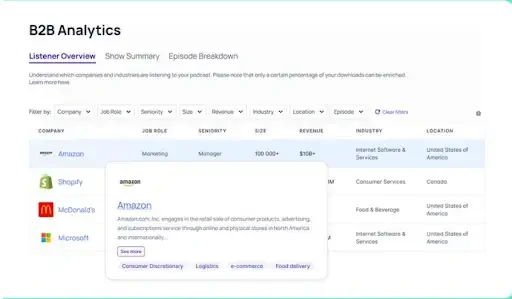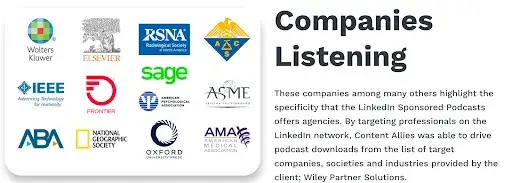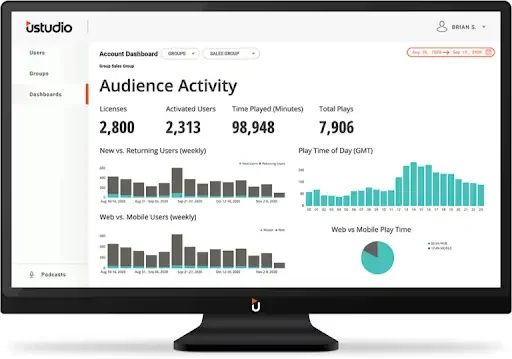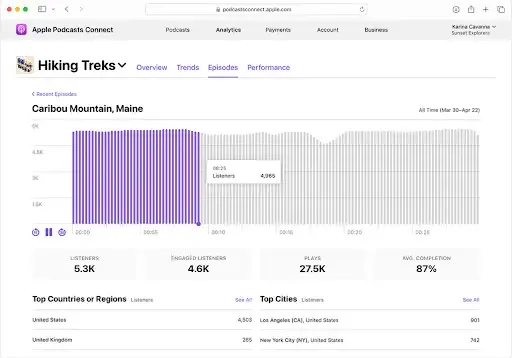Corporate Podcast Strategy: Building Internal and External Audiences
A clear corporate podcast strategy helps your company talk to employees and the market with one coordinated plan.
This guide shows how to run an internal communications podcast and an external thought leadership show on a shared workflow that your teams can manage, measure, and scale.
Having this plan is essential today, when podcast budgets now face more scrutiny, and leaders want proof of business impact.
Besides, industry data shows that 46% of weekly podcast listeners have purchased a product or service because of a podcast ad, which signals a direct path from content to outcomes when execution is solid.
In this guide, you will see:
A dual-track framework
Planning steps for audience segmentation
Formats that fit executive communications and employee engagement
A distribution plan that covers video and audio
A measurement model you can share in QBRs
We will also link to supporting playbooks so your team can move fast, including scripting guidance and sponsorship strategy.
Let’s dive in.
What Is a Corporate Podcast Strategy?
A corporate podcast strategy is a plan that sets goals, audiences, formats, and governance for both internal communications and external thought leadership.
It aligns podcast planning, production, distribution, and measurement in one workflow so teams ship on schedule and repurpose episodes across channels.
Why Podcasts Are Becoming Core Communication Channels
Leaders now treat podcasts as a routine way to reach employees and customers.
The numbers prove this:
According to Edison Research, weekly listening in the U.S. is an estimated 115 million people, and video viewing grows that reach even more.
YouTube is the service used most often by weekly podcast listeners, which makes podcasts a natural fit for company channels and exec visibility.
Budgets follow attention.
U.S. podcast ad spend reached an estimated $2.28 billion in 2024, with continued growth forecast through 2026.
Decision-maker density is also strong. News podcast listeners are 24% more likely to be senior decision makers than the overall podcast audience.
For corporate teams, that means one format can serve brand marketing, executive communications, and recruiting with consistent assets.
Internal vs. External Podcasts: Key Differences
Purpose: Internal shows support leadership updates, onboarding, enablement, and culture. External shows build thought leadership, share customer stories, and open doors for sales and partnerships.
Audience access: Internal shows often live behind Single Sign-On (SSO) or a private feed. External shows publish on open platforms and company channels, including Spotify and Apple Podcasts.
Formats: Internal episodes work well as short CEO updates, manager briefings, or onboarding series. External episodes work well as interviews with customers and partners, product explainers, and executive roundtables.
Success metrics: Internal metrics focus on reach by org unit, completion rate, and actions taken after listening. External metrics track reach by persona, engagement on owned channels, meetings influenced, and sourced or assisted opportunities.
Risks and reviews: Internal content needs governance for privacy, compliance, and timing. External content needs legal and brand checks for quotes, claims, and guest approvals.
| Aspect | Internal | External |
|---|---|---|
| Purpose | Leadership, onboarding, culture | Thought leadership, customer stories, sales |
| Access | Private, SSO | Public, Spotify/Apple, company channels |
| Formats | CEO updates, briefings, onboarding | Interviews, explainers, roundtables |
| Metrics | Org reach, completion, actions | Persona reach, engagement, influenced deals |
| Risks | Privacy, compliance, timing | Legal, brand checks, guest approvals |
Even if these two types of podcasts are different, we argue that you can, indeed, use just one strategy for both.
That brings us to the next point:
The Case for a Unified, Dual-Audience Strategy
A single strategy:
Creates one planning cadence, one production workflow, and one measurement model that serves both audiences. This reduces context switching for teams and keeps quality steady across shows.
The same episode plan can yield internal and external assets. A customer interview can produce a public episode, a case-study clip for sales, a short internal lesson for onboarding, and an executive recap for all-hands.
A unified model makes the gap between leadership beliefs and employee reality visible and then easier to fix.
Lululemon’s internal podcast gives a clear example: the Leadership Series extended HQ speakers to a global team and reached 75% of staff with a 95% average consumption rate.
In turn, this gave communications leaders reliable signals on what messages landed and where to adjust the topic mix and cadence.
Pair numbers like this with external reach and response in QBRs, and leaders get one view of how messages perform across both audiences.
How to Build a Corporate Podcast Strategy Step by Step
Use this playbook to plan two tracks with one system. Set goals, map audiences, pick formats, and align production so both shows ship on schedule and feed your reporting.
Step 1 – Define Strategic Goals for Internal and External Podcasts
Set one primary outcome for each track, then agree on how you will measure it. Write the outcome in a single sentence, share it with stakeholders, and lock the first reporting date.
What success looks like for internal podcasts
Internal podcasts can scale leadership messages across a global workforce and lift alignment when leaders package town-hall content as short episodes.
Success means faster onboarding, stronger cultural alignment, and clear leadership updates that people can play on their own time.
Use metrics you can verify every week:
Completion rate by org unit
Unique listeners against headcount
Follow-on actions like course enrollments or policy acknowledgments
Set targets in your editorial calendar and review them in QBRs.
Keep a simple dashboard: episodes shipped, reach by team, median completion, and one action taken after listening.
Pro tip: See more KPIs you can use in this Content Allies’ guide for consistent reporting
What success looks like for external podcasts
Success means reaching the right buyers, creating sourced meetings, and supplying deal-stage clips that help sales. Track:
Persona-level reach from episode pages
Meetings created from guest and listener touches
Opportunities influenced
As we explained above, 46% of weekly podcast listeners have purchased a product or service after hearing an ad. And this signals a direct path from content to commercial outcomes when distribution and follow-up are in place.
P.S.: To learn how to use your external podcast to connect with decision makers, check out this guide: Beyond the Interview: How to Leverage Guest Content for Long-Term Relationships
How to choose KPIs and align stakeholders
Map KPIs to owners so each team sees its work in the numbers.
Marketing and Communications: persona reach, episode page actions, newsletter clicks, sourced meetings.
HR and Internal Communications: unique listeners vs. headcount, completion by org unit, survey lift after leadership updates.
Enablement: number of clips added to playbooks, content usage by reps, and deal velocity on opportunities where clips were sent.
Legal and Brand: pre-flight approvals met, accessibility checks passed, zero escalations.
RevOps: influenced pipeline with UTMs, meeting creation, and opportunity stage progression tied to episodes.
Step 2 – Decide Your Corporate Podcast Program Structure
One show or two?
Decide if you will run a split-feed or a shared series. If your internal content needs access controls, pick a dedicated internal show with Single Sign-On (SSO) or private distribution, then run a public show for market audiences.
Platforms built for private podcasts support enterprise security and listener analytics, which makes internal reach and completion easy to track.
If your topics overlap and risk duplicate effort, use one public show with clear segment tags and a private “briefing” spin-off for employee updates.
Pro tip: Keep names, artwork, and tone distinct enough that each audience knows when an episode is for them. For format tradeoffs and naming rules, check out our guides on choosing your format and brand guidelines.
Who owns the podcast: centralized vs decentralized production
Pick an operating model first, then assign owners.
A centralized model puts Marketing or Corporate Comms in charge of calendars, production, and QA, which simplifies governance and brand control.
A decentralized model lets business units pitch and record, with a small central team that edits, legal-checks, and publishes.
Teams can run this two ways.
Meta shows what a decentralized model looks like: engineering hosts the Meta Tech Podcast, other groups run their own shows like the Meta, Business Innovation, and Technology Podcast that Content Allies produces, and each team ships on its own cadence.
Siemens illustrates a hub model with an official Podcast Network page that aggregates many shows under one roof, which keeps brand control and discovery in one place.
Many large enterprises also curate multi-show catalogs; Cisco’s Podcast Network collects programs from different business units and audience goals.
Pro tip: Lock this in a one-page Responsible, Accountable, Consulted, and Informed (RACI) and link it to your KPI scorecard so every team knows what they own. For planning structure, use our strategy workflow plan.
Podcast formats that work for corporate goals
Match formats to jobs-to-be-done, then standardize runtimes so you can ship on schedule.
Interviews for customer stories, partner spotlights, and exec positioning.
Updates/briefings for leadership messages, onboarding, and enablement.
Roundtables for cross-functional topics and external thought leadership.
Narrative mini-series for product education and change management.
Plan for video and audio. Among weekly podcast listeners, YouTube is the service used most often, so a video-first workflow lifts discovery for the public track and gives internal teams clips they can reuse in onboarding or training hubs.
For format details and episode planning, use these playbooks: step-by-step episode guide, format selection, and enterprise considerations.
Step 3 – Build a Shared Editorial Calendar
Plan by campaign, quarter, or initiative
Anchor both tracks to the same marketing calendar. Pair internal updates with external launches, events, or themes so each publish window pushes in the same direction.
Use a rolling 12-week view to slot topic research, recording, editing, and promo assets, then tie each episode to a business action.
Keep cadence predictable so approvals and assets land on time.
Schedule around attention peaks.
Most podcast listening happens Monday to Friday, with commute spikes near 8 a.m. and 5 p.m., so plan releases and promos to match listener habits.
Identify dual-use content opportunities
Plan segments that serve both audiences from one recording day. For example:
Executive interviews can yield a public episode, a short internal briefing, and meeting-ready clips.
Customer spotlights can power case-study pages and onboarding vignettes.
DEI stories can ship as culture updates internally and values content externally.
Lock these reuse paths in the calendar before you hit record, so editing, thumbnails, and copy flow without extra cycles.
Lock review cadences and sign-off windows
Publish on schedule by fixing review gates in advance. Set first-cut review, legal and brand checks, and final asset approval as calendar events with owners and Service Level Agreements (SLAs).
Pro tip: Batch recurring tasks like title polish, show notes, and thumbnails, so nothing blocks the release. Use one RACI and an approval SLA for both tracks, then track hit rates in your KPI dashboard each quarter.
Keep a release rhythm that supports campaigns and QBRs.
Podcast ad revenue continues to grow past $2B in the U.S., which rewards teams that ship predictably and measure outcomes quarter over quarter.
Step 4 – Corporate Podcast Production Workflows
Internal podcast workflow
Brief. Create a one-page episode brief with goal, audience, host notes, segment outline, and required approvals. Use your show charter and brand guidelines to lock tone and naming before scripting.
Record. Batch recordings. Capture host intro, the core segment, and a short manager takeaway in separate tracks to speed editing and reuse across onboarding and training hubs.
Edit. Apply a standard structure: cold open or hook, branded intro, main segment, action recap, close. Produce transcripts and captions in the same pass to meet accessibility requirements.
Compliance. Run content through legal, HR, and brand checks using a fixed gate: first cut approval, quote approval, then final asset approval. Track SLA hit rate on each gate.
Publish. Upload to the private feed and LMS or intranet with role-based access. Post a summary and link in Slack or Teams with a simple CTA, for example “acknowledge policy” or “enroll in module.” Map each drop to your 12-week calendar so cadence stays predictable.
External podcast workflow
Brief. Define the episode goal, target persona, one problem to solve, and the asset plan you will repurpose. Attach run-of-show and guest prep.
Record. Capture the host intro, interview, and a short executive recap. Mark moments for clips during the session so producers can pull highlights without rewatching full files.
Edit. Follow a consistent episode architecture with clean pacing. Produce show notes, chapters, and a summary for the episode page. Prepare two to four clips and a square thumbnail variant using your brand kit.
Legal. Clear quotes, product claims, and guest approvals in a single pass, then lock the final audio and video. Route through one edit-and-approve lane to keep cycle time steady.
Publish. Release to your host via RSS, publish video to YouTube, and ship the episode page on your site with SEO title, meta, transcript, and internal links. Add UTMs to all buttons so RevOps can attribute meetings and opportunities. Use the enterprise episode guide for the full checklist.
Operational notes. Tie each release to a campaign or initiative and schedule newsletter, LinkedIn, and partner posts inside the same calendar entry. Maintain a two-episode buffer to protect cadence. The 12-week rhythm from planning to distribution keeps teams aligned and assets ready at publish.
Standardize roles, SLAs, naming conventions, and templates
Roles and SLAs. Publish a one-page RACI that names the owner for briefs, recording, edit, legal, and publishing. Set simple SLAs: 2 business days for first-cut review, 2 for legal and brand, 1 for final asset approval. Track hit rate and surface misses in QBRs.
Naming conventions. Standardize file names so handoffs never stall:
INT_[Episode#]_[YYMMDD]_Topic_Speaker for internal, EXT_[Episode#]_[YYMMDD]_Guest_Topic for external. Use the same slug on the episode page, the project folder, and the clip exports. Map short titles and long SEO titles in your brand guidelines doc.
Templates. Store editable templates for briefs, run-of-show, show notes, titles and descriptions, thumbnails, and clip captions. Keep versioned checklists for internal and external workflows so producers can move fast without quality drift. Reference the scripting workflow and brand kit articles when creating these templates.
Calendar alignment. Use a shared 12-week calendar to link production steps to campaign dates. Include fields for KPI target, guest status, and repurposing plan. This turns the calendar into your operating manual and prevents last-minute churn.
Pro tip: For a deeper dive, we put together Podcast Scripting Made Easy: Agency-Level Examples & Tips That Work.
Step 5 – Set Up Distribution: Best Channels to Distribute a Corporate Podcast
Here, let’s look at internal and external channels and how to repurpose content across them:
Internal channels
Use an SSO-friendly podcast platform so employees can listen on any device without sharing links. uStudio, Podbean Enterprise, and Staffbase support private feeds, role-based access, and completion analytics, so they’re pretty solid to begin with.
Then, pair each release with a short post in Slack or Teams that includes the episode card, one clear action, and a deadline.
Move longer trainings into Workday or Docebo as LMS modules with an embedded player and a quick check or acknowledgment so HR can record completion.
External channels
For external podcasts, we recommend setting up on a podcast hosting platform like CoHost so reporting is actionable. In addition to hosting your podcast, CoHost provides company and role-level insights, episode benchmarks, and attribution exports that your RevOps team can match in the CRM.
Pro tip: Keep UTMs consistent across the episode page, player links, YouTube descriptions, and LinkedIn posts so Step 6 has clean data to measure and optimize.
Next:
Ship to Apple Podcasts and Spotify through your host, then publish a complete episode page on your site with a transcript and internal links.
Add video versions to a YouTube playlist with chapters so people can scan topics and jump to sections.
Activate LinkedIn with a native clip and a short caption that names the problem the episode solves, then link to the episode page.
Close the loop with a newsletter section that features the one episode your audience should play this week and a secondary clip for skimmers.
Repurpose corporate podcast content across channels
One interview can power a full content ecosystem when you plan distribution up front. Here’s what we advise you to do:
Start by pulling the core insights and quotes from the recording.
Look for a tactical framework, a strong point of view, or a personal story that lands.
Turn these moments into short video clips, LinkedIn carousels, and pull-quote graphics. Aim for three to five solid assets per episode so every publish has reach and depth.
Distribute with intent. Post clips on your company LinkedIn page, tag the guest, mention their company, and reply to comments to keep the thread active.
Ask the guest to share with their audience and include a ready-to-post media kit.
Use LinkedIn Ads to promote top-performing clips to the same roles and industries as your target accounts.
Feed internal teams at the same time. Give sales a highlights folder with clips that map to common objections and buyer roles. An account rep can send a CIO clip to other CIOs as a warm touch. Add short segments to onboarding and training hubs so employees hear the same language customers hear.
P.S:. To learn how to use repurposed content to build external audiences, check out this guide: Podcasting for Enterprise Brands: How to Engage Decision-Makers at Scale
Paid distribution to grow external reach
Treat paid distribution as non-negotiable for external shows. It protects growth, reaches the right people, and proves value fast.
We at Content Allies retained Wiley Partner Solutions by pairing the Research Impact Podcast with LinkedIn Sponsored Podcasts through Listen Network.
The campaign delivered ~7,000 IAB-verified downloads with a 64% consumption rate and hit the exact ICP across named companies and industries, which stabilized results and kept the engagement.
Use paid media to reach the people your sales team names, so target:
Accounts and buyer roles on LinkedIn
Intent topics on YouTube
Category placements through podcast networks
Run each placement with its own UTM and KPI so RevOps can show meetings, influenced opportunities, and repeatable cost per download.
Our team at Content Allies applies this approach to get downloads from the company’s actual target ICP, not broad listeners, by matching campaigns to named accounts and industry filters.
Step 6 – Measure, Attribute, and Optimize
In this section, we’ll show you the internal and external metrics you need to keep an eye on, and how to optimize your results.
Internal metrics to monitor
Measure how far messages travel and what people do next. Track unique listeners against eligible headcount, completion by org unit, and quick pulse signals like CSAT on post-episode surveys.
Private podcast platforms publish adoption and completion analytics that make this simple to report and improve.
Most importantly, tie episodes to outcomes. For onboarding, compare time-to-complete and course enrollments after episode drops. For leadership updates, capture acknowledgments and policy reads.
Pro tip: Keep a shared dashboard so Internal Comms and HR see the same view each week.
Add a short feedback loop to every internal release. Ask one question about clarity or usefulness, then use the next episode to address what people requested.
External metrics to monitor
Focus on subscriber growth, watch time, and revenue signals your exec team recognizes. Apple Podcasts surfaces listener and completion analytics, which show how well your episodes hold attention.
Spotify reports listeners, starts, streams, and followers; followers are strong because followers listen to four times more episodes on average, while CoHost provides company-level and role-level insights and enhanced B2B views for ROI reporting so RevOps can connect listens and downloads to the pipeline.
We advise you to report sourced meetings and sales touchpoints next to media metrics.
Use UTMs on episode pages, player links, YouTube descriptions, and LinkedIn posts so you can match traffic and meetings in the CRM.
Follow the Interactive Advertising Bureau (IAB) podcast measurement guidelines for download counting, then use platform engagement to tell the quality story.
Set Up Your Corporate Podcast with Content Allies
Content Allies builds dual-track programs that serve employees and the market with one coordinated plan.
Strategy comes first.
We start by understanding your world through a structured questionnaire and a kickoff working session, then turn that input into a clear show concept, format, and practical launch plan your leaders can approve.
When stakeholders need a summary, we package the plan in a short deck with the action path, go-to-market, KPIs, and brand direction so your teams move in sync.
Production runs on an enterprise-ready system.
Internal shows publish securely with private access and the right approvals. External shows publish across your site, Apple Podcasts, Spotify, YouTube, and other major podcast platforms.
Pro tip: Attribution, paid distribution, and repurposing are wired in from day one.
Governance is simple to follow because charters, brand guidelines, and review gates are in place before the first recording. Your program stays organized and measurable without slowing down.
Results roll up in a simple scorecard.
Every 90 days, we deliver a Quarterly Business Review (QBR) that shows downloads, consumption, subscribers, and channel performance. The review highlights what to scale and what to refine, so momentum compounds quarter over quarter.
At Content Allies, we bring the structure, production quality, and analytics discipline needed to make a corporate podcast work for internal communications and for the market at the same time.
If you want a partner who can design the strategy and run the system end-to-end, let’s talk.
FAQs
What is a corporate podcast strategy?
A corporate podcast strategy is a structured plan for using podcasts to engage both internal teams and external audiences. A successful podcast aligns with business goals, business communications, and content marketing workflows, often supported by strong storytelling ability and professional sound quality.
How do internal corporate podcasts help employee engagement?
Internal podcasts boost employee engagement by sharing leadership updates, onboarding content, culture stories, and enablement resources. Delivered through private podcast channels, they provide scalable, asynchronous content solutions that fit into employees’ daily workflows.
What’s the difference between internal and external podcasts?
Internal podcasts are private and employee-focused, supporting communication, training, and alignment. External podcasts are public-facing, designed to improve search engine visibility, build brand awareness, and drive thought leadership through storytelling ability and authentic content marketing.
Can one podcast serve both employees and customers?
It’s possible, but many enterprise teams benefit from separate shows tailored to each audience’s needs, tone, and distribution channels. Keeping internal shows on private podcast channels while external shows live on public platforms ensures clarity and effectiveness.
How do you measure ROI on corporate podcasts?
For external shows, ROI includes pipeline influence, search engine visibility, content engagement, and meetings booked. For internal shows, ROI focuses on reach, completion rate, onboarding impact, and employee feedback. Both approaches rely on clear business communications goals and well-defined content solutions.


